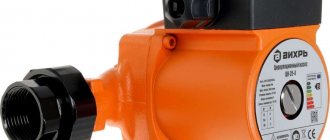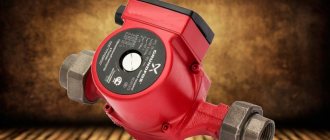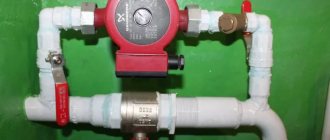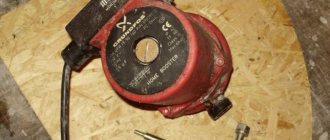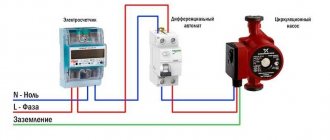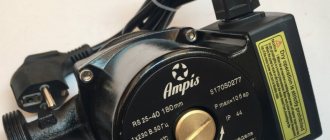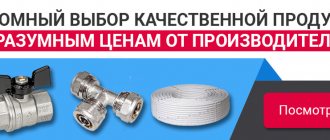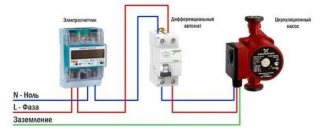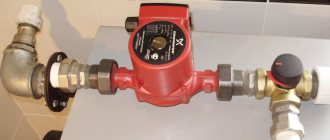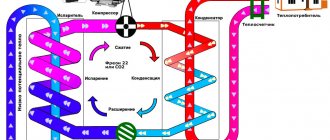Quite recently, purchasing and installing a circulation pump in a heating system was considered not an easy task. Since most owners of country houses believed that a heating system with natural coolant circulation is much more efficient than a forced one.
However, practice has shown the opposite; with the advent of circulation pumps, it became no longer advisable to use an outdated design with natural circulation. Why? You will learn about this by reading the article to the end, and we will also give a detailed answer to the main question of the day: “How to install a circulation pump in a heating system?”
Due to the operation of the circulation pump, the speed of movement of the coolant in a closed circle increases significantly. Why is this necessary, let's figure it out together:
- The heating time of radiators and individual heating circuits has been reduced to a minimum.
- With a decrease in the heating time of the room, the load on the boiler equipment is reduced.
- It is possible to install a heated floor system and connect it to a common line.
- With the advent of a circulation pump, the cost of fuel resources will significantly decrease.
- You can adjust the temperature in individual rooms by increasing or decreasing the flow rate of the coolant.
It is also worth noting that when using a circulation pump there is no need to use large diameter pipes for the heating system. You can use compact components that will produce thermal energy no less than bulky equipment.
First of all, in order to correctly select a circulation pump, it is important to know in detail the heating system of your home. If the highway has high rises, then it is necessary to choose a unit with increased power. For an extended system, but without rises, you can choose a circulation pump with a more intense flow rate.
Secondly, it is important to know the types of circulation pumps, there are only two of them. With “wet” and “dry” electric motor rotor.
Glandless circulation pump
The electric motor of this equipment has a unique feature. The stator does not come into contact with water and is located in a separate glass. In turn, the rotor is located in the coolant and cools the working parts of the circulation pump. Also, the liquid poured into the heating system acts as a lubricant for the rubbing parts of a wet-rotor circulation pump.
Such products practically do not emit noise and vibration during operation, but do not have high efficiency and low power. Therefore, the main area of application for a wet rotor circulation pump is private houses up to two floors with an average length of heating system.
It is important for the correct operation of this equipment not to leave the internal parts dry for a long period of time. Otherwise, deformation of the rubber seals will occur. If this happens, the pump will have to be replaced with a new one, since it is not dismountable.
Types of pumps and their features
Various circulation units can be installed in the heating system of a private house. They are divided into two large groups. The circulation pump can be “dry” or “wet”. When installing devices of the first type with your own hands, you should take into account that their motor is separated from the working part by sealing rings. They are made from stainless steel. During the startup of the installation, the process of movement of these rings begins, which leads to sealing of the connection with a water (very thin) film. The latter is located between the seals.
Circulation pump unit
High-quality sealing in this case is ensured due to the fact that the pressure in the external atmosphere and in the heating system itself is characterized by different indicators. A “dry” pump makes quite loud sounds when operating. In this regard, its installation is always carried out in a specially soundproofed separate room of a private house. The efficiency of such a circulation unit is at the level of 80%.
Dry rotor circulation pump
Pumps of this type are equipped with a conventional electric motor, the design of which does not provide for the separation of the rotor from the stator. The only thing is that the circulation pump with a dry rotor has a rubber seal mounted on it, which protects the electric motor from the coolant.
Such equipment produces noise and vibration during operation, but has a high power and efficiency level, which allows it to be used in non-residential premises with a large area.
A circulation pump with a dry rotor requires periodic maintenance, namely the replacement of the sealing ring between the impeller and the electric motor. If this is not done, the coolant will damage the electrical area of the pump and cause it to fail.
Direct installation of a circulation pump in a heating system is quite simple. It is enough to tighten the two union nuts located on the pipes and the installation is ready. But the preparatory work requires special knowledge; it is necessary to correctly draw up the insertion diagram and the location of the product. Otherwise, the circulation pump and the entire heating system will not work correctly, which can lead to dire consequences.
Circulation pumping units - design and principle of operation
Closed heating systems require forced circulation of hot water. This function is performed by circulation pumps, which consist of a metal motor or rotor attached to a housing, most often made of stainless steel. The release of the coolant is ensured by the impeller. It is located on the rotor shaft. This entire system is driven by an electric motor.
Circulation pump
Also in the design of the described installations there are the following elements:
- shut-off and check valves;
- flow part (usually made of bronze alloy);
- thermostat (it protects the pump from overheating and ensures economical operation of the device);
- work timer;
- connector (male).
When installed in a heating system, the pump draws in water and then delivers it into the pipeline due to centrifugal force. This force is generated when the impeller produces rotational movements. The circulation pump will work effectively only if the pressure it creates can easily cope with the resistance (hydraulic) of various components of the heating system (radiator, pipeline itself).
How should the circulation pump be positioned?
How the circulation pump should be positioned is a question that concerns many owners of country houses.
- First of all, the pump should be in a horizontal position, and the cable connection box should be located on the side or on top. This is necessary so that it does not flood in the event of a coolant breakthrough from the system.
- The circulation pump can be installed either on the return or on the supply; it is important that it is located between the heating radiator and the boiler equipment.
- It is prohibited to install the circulation pump far from the boiler, otherwise low pressure flows will occur.
- An arrow located on the body of the unit indicates the direction of movement of coolant flows. This point must be strictly observed.
About the choice of equipment and the rules for its independent calculation
The key indicator that determines the efficiency of the circulation pump is its power. For a household heating system, there is no need to try to purchase the highest-power installation. It will only make a loud noise and waste electricity.
Mounted circulation pump
You need to correctly calculate the power of the unit based on the following data:
- hot water pressure indicator;
- pipe section;
- productivity and throughput of the heating boiler;
- coolant temperature.
Installation of a circulation pump
As a rule, the circulation pump is installed using a bypass. Let's take a look at the drawing to familiarize ourselves with this circuit in detail.
The good thing about installing a circulation pump through a bypass is that you have the opportunity to switch from forced circulation to natural circulation at any time. In addition, you can replace a failed circulation pump with a new one at any time, without draining the coolant.
Now, let's look at the installation of a circulation pump in the heating system step by step:
- First of all, we select a free and convenient place for installing the bypass.
- Then we prepare all the necessary elements to connect the nodes. Here you need to have a coarse filter, connections for connections, nuts and taps.
- Then we connect a coarse filter, shut-off valves and drains to the circulation pump. The design should be similar to that shown in the diagram.
- Now we need to embed the bypass valve and only after that weld the prepared structure with the pump.
- We tighten all the elements with a key.
- As soon as the structure is completely installed in the heating system, we connect the pump to the power supply.
- All that remains is to ventilate the heating system. To do this, fill it with water and do not completely unscrew the plug on the body of the running pump. As soon as the noise of the pump stops and water with bubbles stops coming out through the unscrewed plug, the system will be completely de-aired.
Harness
There are two types of heating systems - forced and natural circulation. Systems with forced circulation cannot work without a pump; systems with natural circulation work, but in this mode they have lower heat transfer. However, less heat is still much better than no heat at all, so in areas where electricity is often cut off, the system is designed as hydraulic (with natural circulation), and then a pump is installed into it. This gives high heating efficiency and reliability. It is clear that the installation of a circulation pump in these systems is different.
All heating systems with heated floors are forced - without a pump, the coolant will not pass through such large circuits
Forced circulation
Since a forced circulation heating system without a pump is inoperative, it is installed directly into the gap in the supply or return pipe (of your choice).
Most problems with the circulation pump arise due to the presence of mechanical impurities (sand, other abrasive particles) in the coolant. They can jam the impeller and stop the motor. Therefore, a mesh dirt filter must be placed in front of the unit.
Installing a circulation pump in a forced circulation system
It is also advisable to install ball valves on both sides. They will make it possible to replace or repair the device without draining the coolant from the system. Turn off the taps and remove the unit. Only that part of the water that was directly in this piece of the system is drained.
Natural circulation
The piping of the circulation pump in gravity systems has one significant difference - a bypass is required. This is a jumper that makes the system operational when the pump is not working. One ball shut-off valve is installed on the bypass, which is closed the entire time the pumping is running. In this mode, the system operates as forced.
Installation diagram of a circulation pump in a system with natural circulation
When the electricity goes out or the unit fails, the valve on the jumper is opened, the valve leading to the pump is closed, and the system operates as a gravity system.
Installation features
There is one important point, without which the installation of the circulation pump will require rework: it is necessary to rotate the rotor so that it is directed horizontally. The second point is the direction of flow. There is an arrow on the body indicating which direction the coolant should flow. This is how you turn the unit so that the direction of movement of the coolant is “in the direction of the arrow”.
The pump itself can be installed both horizontally and vertically, just when selecting a model, make sure that it can work in both positions. And one more thing: with a vertical arrangement, the power (pressure created) drops by about 30%. This must be taken into account when choosing a model.

